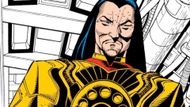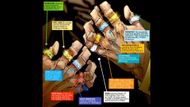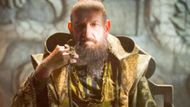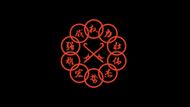They once pulsed with alien power, forged in the heart of a dragon's starship and bound to the fingers of a conqueror. In the early days of Marvel Comics, the Ten Rings were tools of science masquerading as sorcery, worn by the villain known only as the Mandarin. Each ring, a relic of Makluan warlords, channeled energy from distant galaxies into precise destruction. Fire. Ice. Mind. Matter. Their logic was technical, their threat universal. But then came Shang-Chi and the Legend of the Ten Rings—and with it, a transformation not just of character, but of origin, purpose, and myth.
The MCU did more than just update the rings. It broke them open. Recasting their shape as armbands, Marvel untethered the relics from alien lore and bound them instead to something far older and more intimate: a family, a bloodline, a world behind the world.
Wenwu became not a man corrupted by power, but a father preserved by it, his immortality a side effect of grief and will. The rings no longer whispered with cold circuitry. They sang with ancestral memory. And Shang-Chi, once the son of a pulp villain, became the heir to a rewritten legacy.
In this article, we trace the journey of the Ten Rings from the depths of sci-fi pulp to the heart of Chinese folklore, from cold metal to sacred weapon. What Marvel did was more than a redesign: it was a myth rebirth. And the signal they left behind? That may yet awaken something far older than any dynasty.

Origins of warlords and stars: the Makluan legacy
Before they encircled the arms of Wenwu, before they hummed with memory and grief, the Ten Rings were born from the ruins of interstellar conquest. In the original Marvel Comics lore, they belonged to the Makluans—an ancient alien race resembling dragons, whose empire stretched across galaxies and whose knowledge outpaced even the Celestials. When one of their ships crashed on Earth, it left behind a vault of alien artifacts. Among them were ten rings, each containing the distilled essence of cosmic war: energy from stars, minds long extinguished, weapons once wielded by intergalactic tyrants.

These weren’t mere accessories. They were programmable engines of destruction, each with its own domain—flame, lightning, disintegration, vortex, psychic force. The Mandarin, a warlord and self-made emperor, uncovered them in a remote valley and claimed them as his own. Worn across his fingers, the rings served not just as tools but as a signature. They made him more than human. More than a dictator. He became a conduit for the wrath of forgotten worlds.
But these relics carried more than power. They held voices. Some versions of the lore suggested that the souls of the Makluans still resided within them, whispering to their bearer, influencing their will. The fusion of mind and machine created a mythology rooted in fear—where the rings were not just used, but communed with. In this cosmology, the Ten Rings were alien, yes, but also haunted. Each one, a prison. Each glow, a warning.
It was a myth built on domination. Cold. Imperial. Extraterrestrial. The kind of origin that made the Mandarin a threat to Earth’s mightiest heroes, but also a caricature cast in the shadow of Cold War-era fears and orientalist tropes. And that made their reinvention all the more necessary and all the more radical.
The father, the rings, and the thousand-year rule
In Shang-Chi and the Legend of the Ten Rings, the relics no longer coil around fingers like weapons waiting to be drawn. They clasp the forearms, close to the pulse, as if synced to the rhythm of the wearer's life. Gone are the Makluan jewels of cold geometry. What remains are rings of motion, momentum, and memory, iron circles that fly, return, fracture stone, and suspend gravity. They strike like fists and ripple like echoes. They are alive with history, not circuitry.
Wenwu, their bearer, is no longer a comic book tyrant or a dragon-obsessed sorcerer. He is a warlord with the burden of centuries, a man preserved by the power he cannot let go. The rings keep him young, unchallenged, invincible—but also sealed in time. Through them, he builds an empire, then watches it rust beneath his hands. Through them, he finds love and loses it. Through them, he raises a son, then trains him as a weapon, hoping perhaps that blood can fill what power could not.
The shift is more than aesthetic. It is mythic. The Ten Rings become not alien devices, but a lineage. They are inherited, not seized. Wenwu doesn’t activate them with thought. He bends them through gesture, through discipline, through grief. In battle, they spiral around him like memories refusing to be forgotten. And when Shang-Chi finally inherits them, the rings change again—not in color, but in rhythm. They no longer clash like thunder. They dance.
This is Marvel’s pivot: from technology to heritage, from universal conquest to generational wound. The Ten Rings are no longer about domination. They are about memory, legacy, and the cost of holding on.

Marvel reclaims the myth: from sacred beasts to ancestral power
When Shang-Chi reaches Ta-Lo, the realm hidden behind a bamboo maze and guarded by creatures older than time, the story shifts again. The Ten Rings, once rooted in conquest and later soaked in paternal grief, begin to resonate with something far older than Wenwu himself. Here, they are not just artifacts of power. They become instruments of balance—attuned not to warlords or war machines, but to the rhythm of a world built on harmony, guardianship, and sacrifice.
Marvel reveals Ta-Lo and folds Shang-Chi’s lineage into it. His mother, Jiang Li, emerges not as a side note in a father’s tragedy, but as the keeper of a divine heritage. Her people ride qilins, raise phoenixes, and speak with dragons not through dominion, but through communion. In this space, the Ten Rings begin to feel less like weapons and more like inheritance, tools that remember. And with that shift, Marvel redefines not only their power, but their meaning.
The ripple continues beyond the screen. In the wake of the film’s success, Marvel Comics reimagined the Ten Rings all over again. No longer Makluan technology, they are rewritten as sacred relics born of Ta-Lo’s own mythos. Each ring, now attuned to a different spiritual force, responds to the wielder’s heart, not just command. Shang-Chi, once estranged from his birthright, now walks as the chosen guardian of these ancient forces, marking a full circle from outsider to heir.
By rooting the Ten Rings in a divine bloodline, Marvel not only grounded the myth in Chinese cosmology, but also gave Shang-Chi something no previous version ever fully embraced: a past that holds, rather than haunts. And in doing so, it turned a sci-fi relic into a sacred question: What does it mean to inherit power, and to choose differently?
Echoes across the void: Marvel’s signal to the stars
They should have been silent. After Wenwu’s death and Shang-Chi’s inheritance, the Ten Rings had found a new pulse, a new wielder, a new purpose. But they didn’t rest. Instead, they called out. In Shang-Chi’s post-credits scene, as Wong assembles Bruce Banner and Carol Danvers to investigate the rings’ energy signature, the relics reveal a new layer, a beacon, ancient and far-reaching, that predates even the sorcerers’ records. The Ten Rings are not done. They are reaching for something. Or someone.
This moment is pure Marvel. A myth reframed, then reopened. A story that loops back into the great celestial architecture of the MCU. The beacon has sparked speculation across fandoms: are the Ten Rings connected to the Eternals and their cosmic technology? Do they resonate with the Celestials, those ancient architects of existence? Could they be older than the multiverse itself, fragments from a time before time? Or are they a tether to Kang, remnants of a reality already collapsing?
But Marvel’s genius lies in refusing to answer too quickly. The rings remain unclassified, suspended in mystery, and yet unmistakably significant. They exist beyond sorcery, outside Wakandan science, untouched by the Time Variance Authority. That makes them one of the few artifacts in the MCU that live outside known systems, anchored neither to the mystical nor the mechanical, but to something entirely new.
In that silence, Marvel plants the seed for its next mythology. The Ten Rings may have begun as alien weapons and become symbols of bloodline and grief, but now they are something more: an open question in a universe that thrives on discovery. A signal humming at the edge of comprehension. A legend still writing itself.

Marvel breaks the mask: from caricature to gravitas
For decades, the Mandarin stood as one of Marvel’s most problematic legacies—a villain shaped less by intention and more by stereotype. A fusion of Cold War fears and orientalist fantasy, he carried the echo of Fu Manchu, cloaked in mysticism that exoticized rather than honored.
His power, his aesthetic, his language, all of it spoke of distance, otherness, and villainy born from misreading. But in Shang-Chi and the Legend of the Ten Rings, Marvel does not erase him. It reclaims him.
Wenwu is no Mandarin. He carries the name, but rejects its meaning. In the film’s quietest moment, he mocks the title as nonsense, an American construction born from fear. What Marvel offers in its place is not a sanitized figure, but a man carved from centuries of love, ambition, and ache. Wenwu is terrifying, yes—but never hollow. His empire is not built on chaos. It is forged through precision, discipline, and the pain of surviving too long.
Marvel reshapes the character by rebuilding the visual language around him. Gone are the yellow-peril robes and generic motifs. In their place, symbols drawn from Chinese calligraphy replace vague tribal marks. The Ten Rings organization is no longer a nameless horde, but a dynasty. Language matters. Costume matters. Even the silence matters. Every frame treats culture not as decoration, but as foundation.
By grounding Wenwu in real grief and real history, Marvel invites something rare in blockbusters: empathy for a man who should have been a monster. His sins remain, but they carry weight. And when Shang-Chi confronts him, it is not to defeat a villain, but to break a cycle—a generational wound passed down through rings, empire, silence.
This is the heart of Marvel’s transformation. Not just myth remade, but meaning restored.

Ten circles, one legacy: how Marvel reforged its relics
The Ten Rings were once symbols of might without memory. They served whoever held them, without question or consequence. But across comics and cinema, Marvel redrew their arc—ring by ring, century by century. What began as alien tech became an inheritance. What once echoed with cold calculation now pulses with grief, with love, with choice.
In Shang-Chi and the Legend of the Ten Rings, the relics no longer orbit a villain’s ego. They move with the weight of generations. They respond to intention, to rhythm, to healing. And when Shang-Chi reclaims them, Marvel closes one loop and opens another. The rings no longer carry the voice of conquest. They carry the future.
This is what it means to rewrite mythology. Not to discard what came before, but to forge it anew—to let metal remember skin, to let power learn restraint. Marvel reforged its relics not by polishing the past, but by letting it fracture, glow, and shift in the hands of someone who dares to wield it differently.
Ten circles. One legacy. Still spinning.
Love movies? Try our Box Office Game and Movie Grid Game to test your film knowledge and have some fun!
